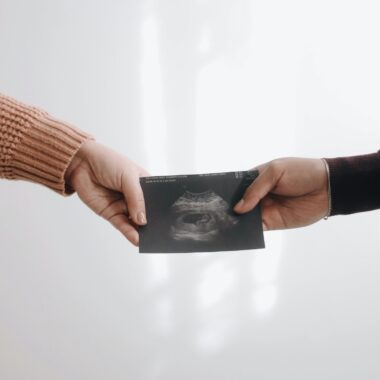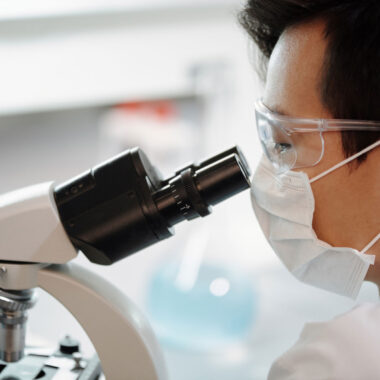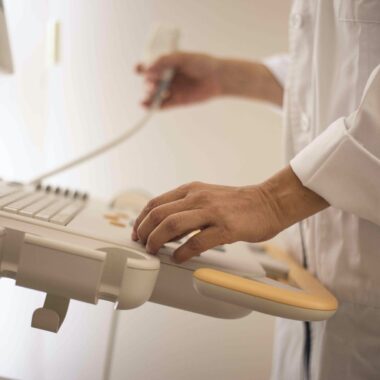In Vitro Fertilization (IVF) at Boca Fertility
Topic Quick Links
So you have tried “conventional” therapy for some time and have not been successful. You may have tried ovulation induction, undergone IUI, or you may have had laparoscopic surgery for fibroids or endometriosis. For one reason or another, the egg and sperm are just not able to “meet“ or implant in the uterus. The problem may be traced to tubal function, pelvic adhesions, egg quality, or pelvic inflammation. It is also possible that the sperm can not get into the egg because of low sperm count and motility or thickened egg shell. What can be done now?
What is IVF?
IVF is the process of fertilizing an egg with a sperm in the laboratory (in vitro) to form an embryo. The embryos are then transferred into the uterus to initiate a pregnancy and a live birth.
What to Expect Before Starting Your IVF Cycle
You may have already completed some of the required testing during your fertility evaluation. Your nurse will go over your file and will let you know what else may need to be done in preparation for IVF.
The procedures or tests prior to IVF may include:
- Hysterosalpingogram or HSG (tubal X rays) within the past 2 years. When the tubes are found to be blocked at their ends (Hydrosalpinx), inflammatory secretions within the fallopian tube find their way into the uterine cavity and adversely affect embryo implantation. Removal of the tubes is therefore recommended before embryo transfer.
- High complexity semen analysis to assess sperm concentration, motility and morphology.
- 3-D Sonohysterogram (Saline Infusion Sonography or SIS) to evaluate the uterine cavity to make sure there are no abnormalities, such as uterine polyps or fibroids, which may interfere with embryo implantation.
- Trial (“mock”) transfer will also be performed with your sonohysterogram. This is a “dress rehearsal” utilizing a soft embryo transfer catheter to make sure that there will be no problem transferring the embryos into the uterus during the IVF cycle.
- Ovarian reserve assessment: Antral Follicle Count or AFC is an ultrasound evaluation to count the number of eggs present in your ovaries. This, together with other ovarian reserve markers (FSH, estrogen and AMH) can help the doctor determine the dosage of hormone injections required to stimulate egg development. High AFC, high AMH and low FSH are usually predictive of good ovarian reserve.
The IVF Cycle
A typical IVF treatment takes about 4 weeks to complete. Your fertility specialist will determine which stimulation protocol is best for you, taking into consideration your age, weight, and ovarian reserve assessment indicators, such as, day 3 FSH (Follicle Stimulating Hormone) level, Antral Follicle Count (AFC) and AMH (Anti Mullerian Hormone) level.
Phase 1: Ovarian Stimulation
The most common stimulation protocol for IVF utilizes an antagonist such as Cetrotide or Ganirelix to suppress your pituitary and prevent premature spontaneous ovulation.
Ovarian stimulation typically begins on day 3 of your menstrual cycle. You will be taking fertility hormone injections for approximately 10 days resulting in development of multiple follicles .
Follicle development and endometrial thickness will be monitored by ultrasound and blood tests. Daily antagonist injections or pills will be initiated on day 6 of ovarian stimulation.
Phase 2: Ovulation Trigger
HCG or Lupron will be administered to trigger ovulation after 10 days of ovarian stimulation when the leading follicles containing the eggs reach a diameter of 20 mm. The Lupron trigger is gradually replacing the Hcg trigger to minimize the risk of Ovarian Hyperstimulation Syndrome(OHSS).
Phase 3: The Egg Retrieval
The eggs are removed from the ovaries by a minor procedure using transvaginal ultrasound guidance, performed in our in-office operating room suite. This takes about 15 minutes to complete and is done using intravenous sedation administered by our board-certified anesthesiologist. Our operating room is certified by the American Association for the Accreditation of Ambulatory Surgical Facilities (AAAASF). You will be going home about 30 minutes later, but plan on resting for the rest of the day.
After the egg retrieval, you will be given medications to suppress your ovary. Expect to begin your menses in 10-14 days. Meanwhile, all of your embryos making it to day 5-7 in the laboratory will be frozen and transferred one at a time starting with your next menstrual cycle.
Phase 4: Egg Freezing
We do not transfer fresh embryos, so all embryos are frozen at the blastocyst stage. The frozen embryos will be thawed and transferred in the subsequent cycle.
This is done for the following reasons:
- The lining of the uterus (endometrium) is stimulated with estrogen levels exceeding 10 times the natural estrogen production during natural or unstimulated cycle. The end result is that the uterine lining may be overdeveloped in comparison with the embryo and may adversely affect implantation.
- Patients may experience significant discomfort after the retrieval, so transferring embryos under such conditions may be stressful to the patient and affect implantation.
- Doing a fresh transfer puts you at a significantly higher risk of OHSS, one of the most serious complications that we see in infertility care
Phase 5: Fertilization in the Laboratory
Now that your eggs have been removed from your ovaries, the next step is for the embryologist to prepare your eggs and the male sperm for fertilization. In conventional fertilization, the sperm and egg are placed in culture media in a round dish. Typically, only one sperm penetrates the egg to initiate fertilization. About 50% of the eggs will fertilize normally to form a zygote. When there are sperm abnormalities and the sperm cannot penetrate the egg, the embryologist can inject a single sperm directly into each egg. This procedure is called Intracytoplasmic Sperm Injection or ICSI.
ICSI (Intracytoplasmic Sperm Injection)
Utilizing ICSI or Intracytoplasmic Sperm Injection, a single sperm for each egg is all that is needed. Using microscopic techniques (micromanipulation) a single sperm is drawn into a very thin-tipped glass pipette. The tip of the pipette is inserted into the egg through the egg shell (zona pellucida) and the sperm is injected into the egg. This process is repeated for each egg. The eggs are returned to the incubator and are checked 24 hours later to see how many are fertilized. About 70 – 80% of the injected eggs will fertilize normally to form a zygote.
Phase 6: Embryo Development in the Laboratory
The eggs and sperm are placed in a dish containing culture media rich in nutrients essential for embryonic development. The dishes containing the eggs and sperm are placed in embryo incubators. A computer controlled system precisely regulates temperature, oxygen and CO2 levels within the incubators conducive for embryonic growth.
The eggs will be checked 24 hours later to see how many of them were fertilized. You will receive a daily briefing from the IVF nurse coordinator, informing you of the embryos development.
Stages of Embryo Development
- Zygote Stage (16-18 hours after fertilization): The fertilized egg showing the male and female genetic material (pronuclei) is called a zygote. Sometimes more than one sperm can penetrate the egg resulting in an abnormal zygote and abnormal development of the embryo.
- 8 Cell Stage (Day 3): At this stage, the zygote has undergone a series of cell divisions resulting in a total of eight cells. After this stage, the cells continue to divide and develop, ultimately forming a blastocyst. At Boca Fertility, a transfer of two blastocysts on day 5 results in an overall delivery rate exceeding 50%.
- Blastocyst Stage (Day 5-6): The embryo is beginning to hatch out of its soft shell (white arrow) and is ready to implant.
Preimplantation Genetic Testing (PGT)
PGT is a genetic test performed on embryos produced during IVF. The test involves biopsy of embryos at the blastocyst stage corresponding to day 5-6 of embryo development in the laboratory. The biopsy utilizes sophisticated microscopic laser technology to remove peripheral cells, called trophectoderm, which are destined to become the placenta. The cells destined to become the fetus are not disturbed. Determining the genetic health of the embryos can help select a healthy normal embryo for transfer into the uterus.
There are two types of embryo genetic tests:
- PGT-A (Preimplantation Genetic Testing for Aneuploidy): PGT-A is a diagnostic test for screening the 23 pairs of chromosomes in IVF embryos to identify those with the correct number of chromosomes (called euploid embryos). Embryos with an incorrect number of chromosomes (aneuploid embryos) are not able to result in a normal pregnancy and are not suitable for transfer.
- PGT-M (Preimplantation Genetic Testing for Monogenic or single gene defect): The test performed on IVF embryos to reduce the chance of having an affected child with a specific genetic disease, such as Cystic fibrosis
Risks and Benefits of Genetic Testing
Preimplantation Genetic Testing is useful:
- For detection of a specific single genetic disorder, decreasing the risk of having an affected child
- Recurrent Pregnancy Loss (RPL) attributed to an incorrect number of fetal chromosomes, such as Down’s syndrome
- Sex selection
- Strongly desiring to reduce risk of potential miscarriage or failed transfer
Some risks of Genetic Testing are:
- Risk of false positive results.
- The biopsy procedure adds to the cost of IVF. At Boca Fertility, we use a validated platform, Juno Genetics, which is the only platform that has been validated in order to decrease the risk of this occurring after false positive results.
Laser Assisted Hatching (LAH)
Assisted hatching is a procedure, performed by the embryologist, to create a small hole in the envelope of the embryo utilizing high powered microscopy and a sophisticated laser beam. This is typically done in the blastocyst stage of embryo development before embryo transfer or in preparation for embryo biopsy.
The Frozen Embryo Transfer Cycle (FET)
After the egg retrieval, you will begin taking Estrogen with your menses for about 2 weeks to prepare the lining of the uterus (endometrium) for embryo transfer. Blood estrogen level and ultrasound will be scheduled to monitor your response to treatment. When your uterine lining is at least 7-8 mm, intramuscular progesterone shots will be administered for 5-6 days. The lining of the uterus is ready to receive the embryos. The embryos frozen on day 5-7 of development will now be thawed and loaded into a catheter in preparation for transfer.
The doctor will discuss with you the number of embryos to be transferred. In general, only one embryo is transferred.
You will be asked to sign consent forms for embryo transfer. Prior to the transfer, you may be given valium to make you feel relaxed and decrease uterine contractions. You will be given a photo of the embryos being transferred for your records.
The Embryo Transfer
You will be provided with a wrist band listing your name, birth date and last 4 digits of your social security. The staff will perform a brief time out to identify you and your embryos before proceeding with the transfer. The embryo transfer is not painful and takes only a moment to accomplish. The procedure feels like a pap smear with a very full bladder. A speculum will be placed in your vagina and the cervix will be cleansed with culture media. Abdominal ultrasound guided embryo transfer is then performed and you will be able to see the ultrasound imaging displayed on a large screen. The soft catheter preloaded with the embryo is carefully advanced into the uterine cavity and the embryo is gently deposited in the center of the cavity.
For those interested in acupuncture, arrangements can be made ahead of transfer. Following the transfer, you will rest for 5-10 minutes before leaving the office. We recommend that you continue to take it easy at home for the next 24 hours, but do not confine yourself to bed rest.
Your pregnancy test will be performed 9 days after the embryo transfer.

From Physician to Intended Mom: Dr. Roberts Shares Her Surrogacy Journey

Debunking Common Myths About IVF

Exploring Male Infertility and its Impact on the Fertility Journey

A Comprehensive Overview of the IVF Process
